9 Sales Presentation Tips that Win Deals, According to New Data
A brilliant sales presentation has a lot going for it.
Unfortunately, the “best” ideas floating around the Internet will likely land you dead in the water.
Why?
They are based on intuition, rather than actual data.
If you’ve followed us at Gong.io, you know we publish data from analyzing sales conversations with our AI-powered platform to figure out what works (and what doesn’t) in sales.
Our data team at Gong.io studied 67,149 recordings of sales presentations from our database of over 1,000,000 sales calls.
We only included sales presentations from screen-sharing platforms like Webex, GoToMeeting, and Zoom.
All of these calls were transcribed, speaker separated to differentiate between the salesperson and the prospect, and tied to CRM records so we could analyze this data against the outcome of sales presentation.
Then, we analyzed the calls using artificial intelligence (AI) and natural language processing (NLP) to identify behaviors that correlate with sales success.
Here’s what we gathered…
Sales Presentation Tip #1: Leave Yourself Out of the Equation
Your prospects don’t care about you.
Sounds harsh.
But, it’s true.
If you’re serious about making a sales presentation that closes deals and generates revenue, take yourself.
This also includes your company’s backstory.
We identified the exact topics that are typically discussed throughout sales presentations, including the time spent presenting a company overview.
When sales professionals talk about their company too much, there is a sharp negative correlation in the odds progressing the deal to the next opportunity milestone, and winning the deal down the road in the sales cycle.
As long as you speak in general terms about your company for 2 minutes or less at the beginning of your sales presentation, you’ll be fine:
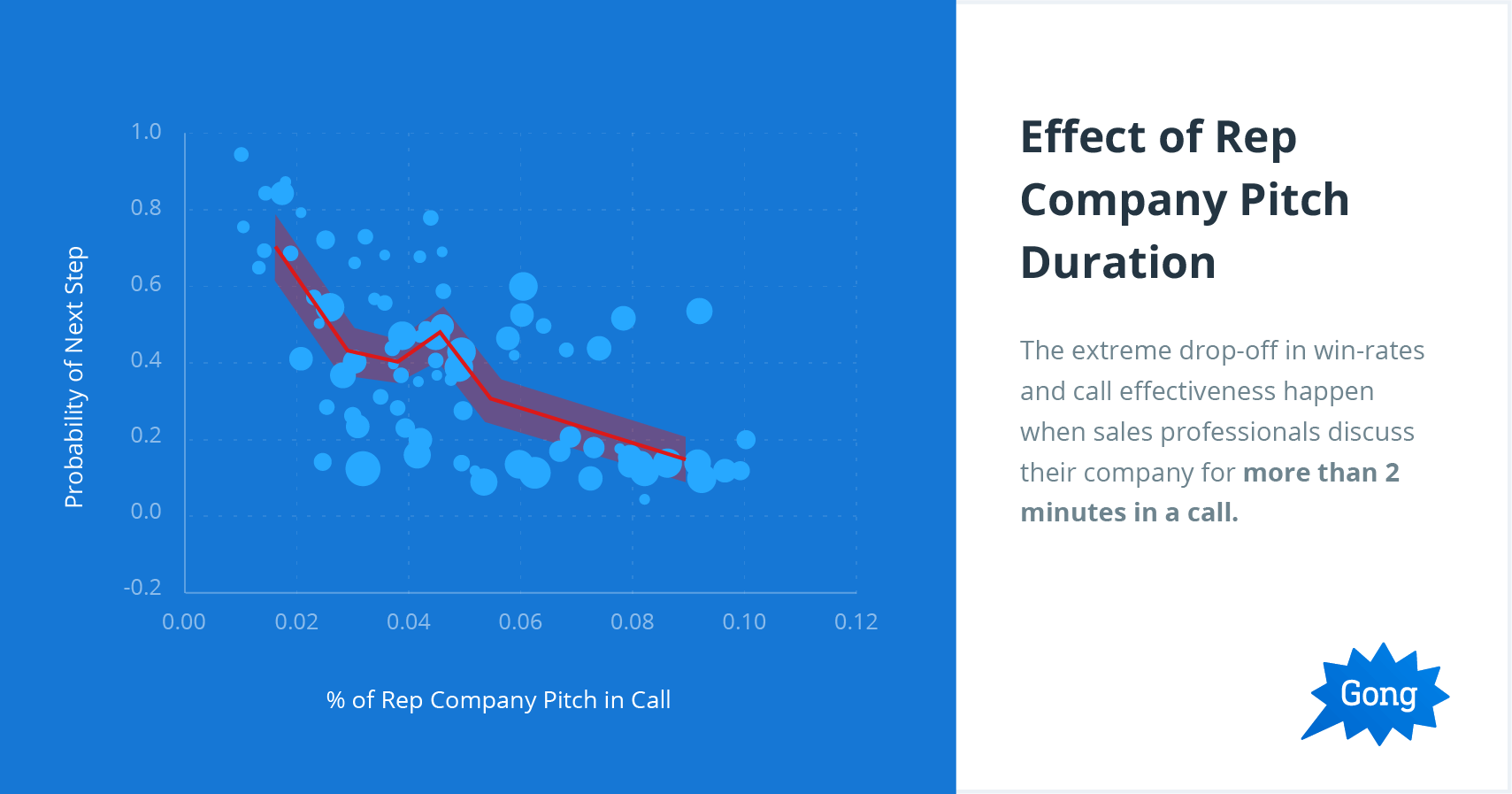
The extreme drop-off in win-rates and call effectiveness happen when sales professionals discuss their company for more than 2 minutes in a call.
First and foremost, your prospect cares about themselves and what you can do for them. They are listening to you to see how you will solve their problems.
Remembering this will help you when you jump to the next step in crafting the perfect sales presentation.
Sales Presentation Tip #2: Provide Context Before You Demo
Sales presentations that lead to closed deals set the context before jumping into the product demonstration.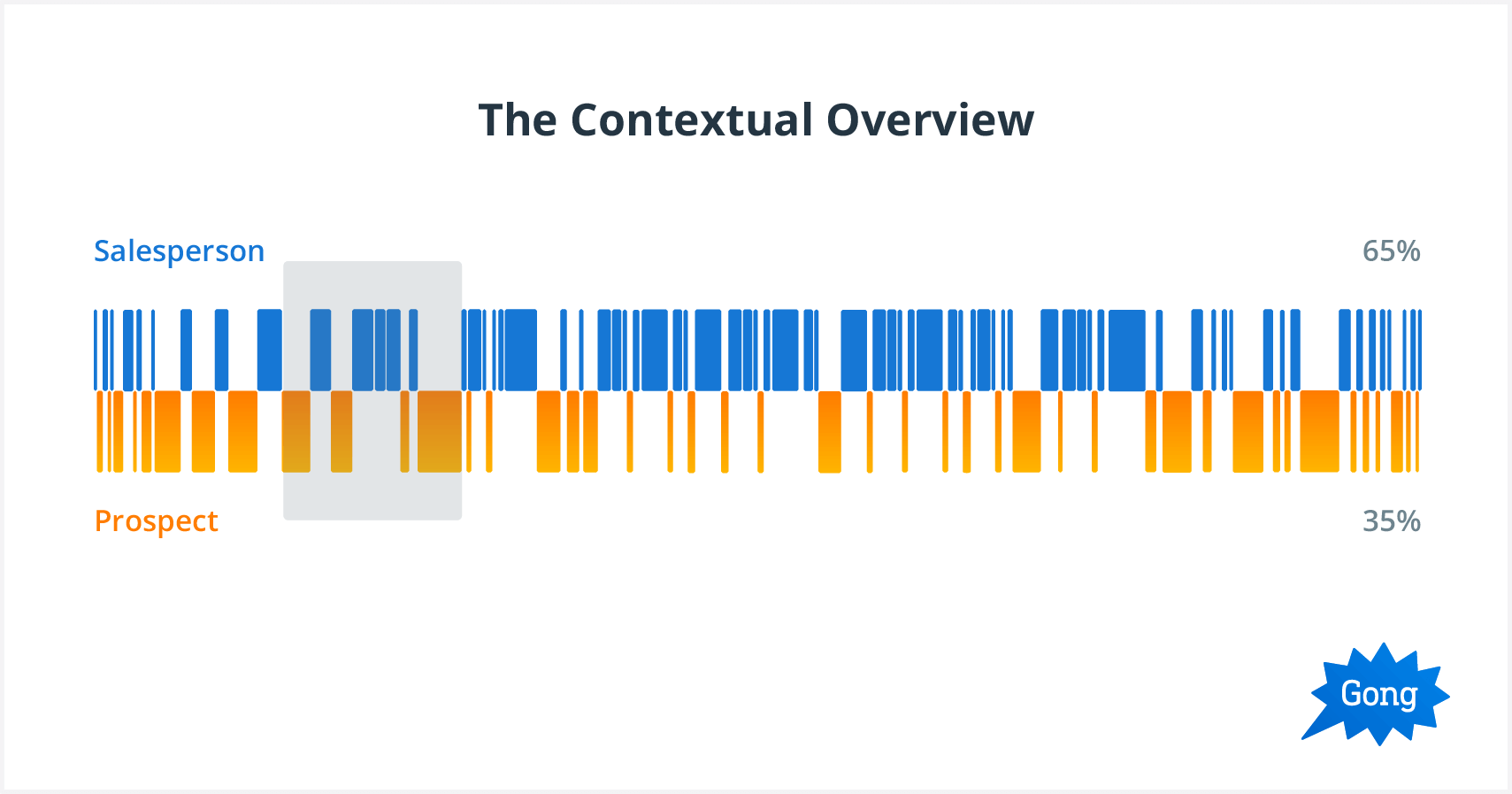
The topics that arose most frequently during the first 10 minutes of successful demo calls were context-building topics: industry problems, narratives, and overviews.
After the initial small talk and greetings of the web conference, account executives who conduct compelling sales presentations prime the prospect with a “contextual overview,” usually lasting less than two minutes.
They give the prospect the needed knowledge and context for the demo itself to make sense and resonate.
The best way to do this is by telling the story of the problem you solve, or the narrative that caused your company to come into existence.
Demonstrating a product and its benefits without the required context in place will give the impression that you have a solution in search of a problem.
What you do and why they should care help to summarize the value you promise to deliver to prospects.
Sales Presentation Tip #3: Don’t Wait Until the End to Win Your Prospect Over
Prospects use the first few minutes of a sales presentation to decide whether or not they want to listen to you for the next hour.
In fact, our research showed successful demos are most commonly conducted in an “upside down pyramid” manner:
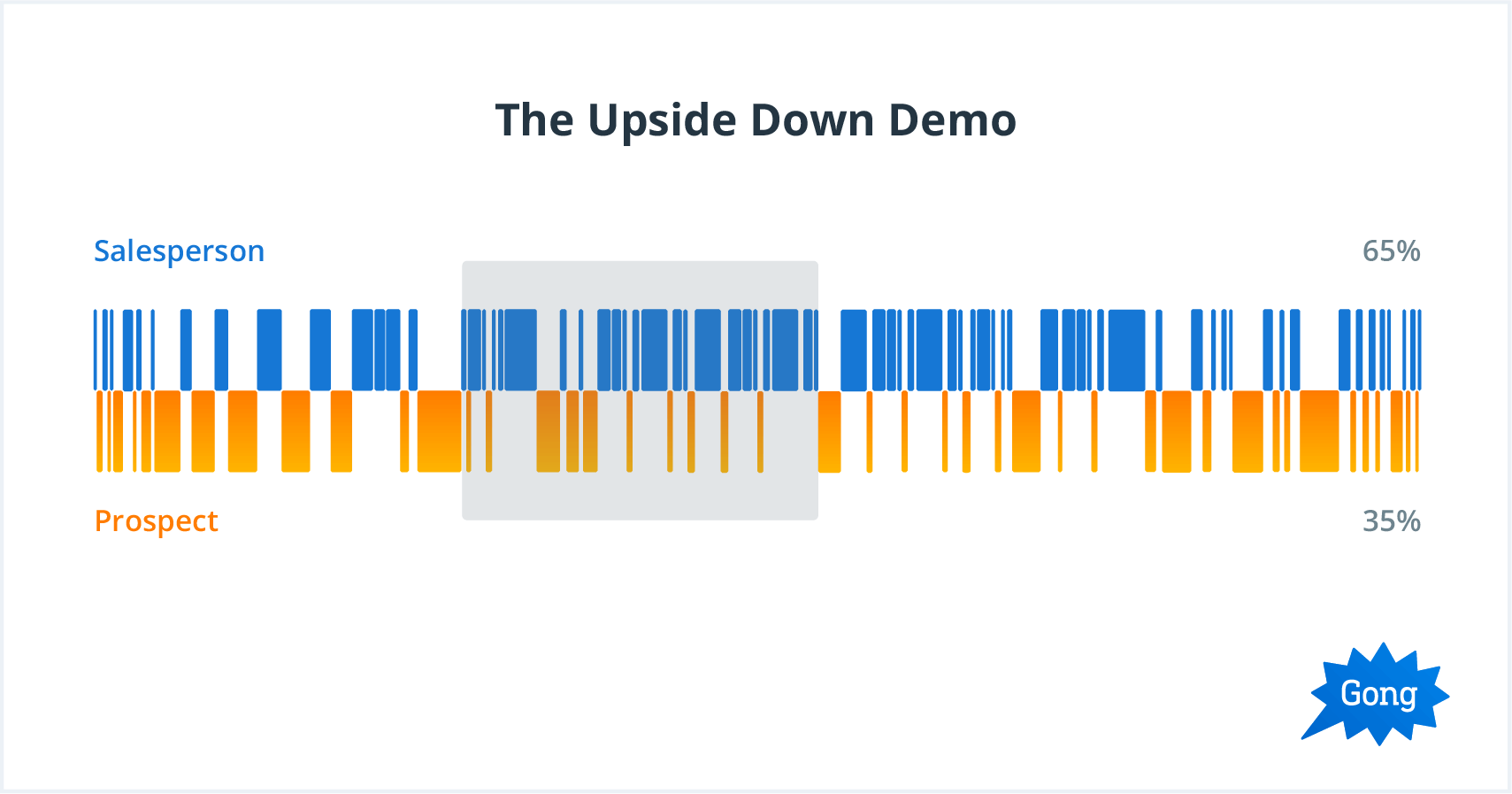
Instead of “building up” to the most valuable part of your demo (“saving the best for last”), winning demos begin with the most valuable part.
Think about it this way…
If a customer spent 7 minutes talking about “coaching,” 4 minutes talking about “onboarding,” and 5 minutes talking about “pipeline management” during the prior discovery call, then the demo would begin by immediately addressing the “coaching” use case, instead of saving that for the end.
Sales Presentation Tip #4: Watch Out for These Reactions
As experienced sales professionals will attest to, when prospect’s response is too good to be true, it often is.
When buyers respond to your sales presentation a little too enthusiastically (with few objections raised), they are actually less likely to buy.
We have the data to prove it.
When analyzing sales call recordings against a sales-specific set of words and phrases, we were able to score the sentiment demonstrated in each conversation.
Every word, sentence, and overall conversation was ranked with one of the following “sentiment scores”:
Very negative (-2)
Negative (-1)
Neutral (0)
Positive (1)
Very positive (2)
And as it turns out, lost deals actually have a 12.8% higher sentiment score than closed-won deals:
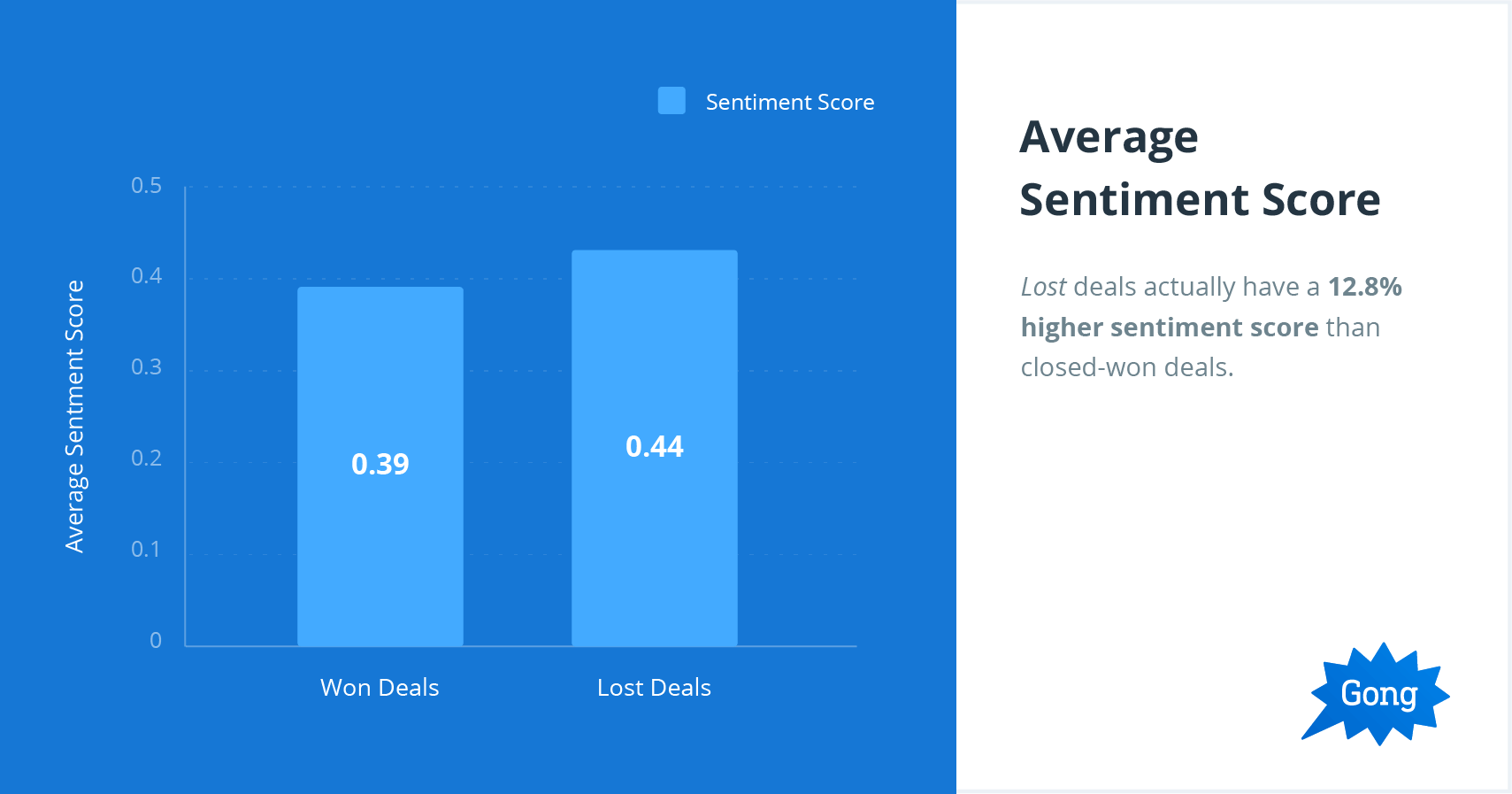
And when buyers express concerns, objections or otherwise “negative” conversation topics, it could be a positive signal for the deal…
See step #7 for further details…
Sales Presentation Tip #5: Show Them Just Enough to Stir the Pot
If you’re getting a ton of questions during demos, that’s a good sign you’ve sparked your prospect’s interest.
Top performers get nearly one-third more questions from buyers during product demos than middle-of-the-pack performers:
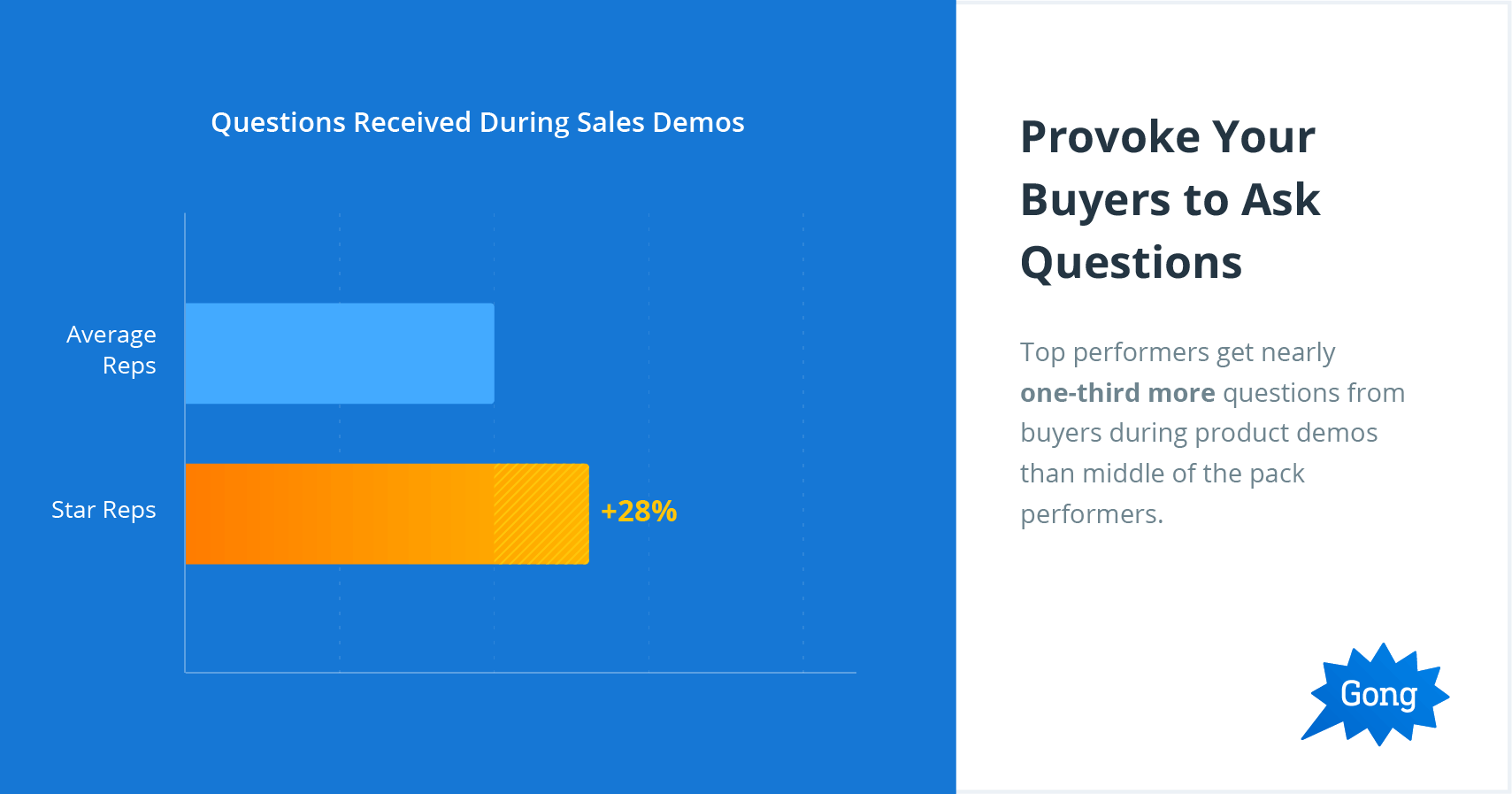
And these reps also ask 30% fewer questions of their buyers during demos.
Why?
They don’t bombard their buyer with information overload.
They show them JUST enough to ‘tease’ them.
It’s almost like their sales presentations are like a movie trailer.
They show just the interesting parts, and in such a way that makes the buyer say “Tell me more!”
They’re giving prospects just enough information to spark their curiosity and provoke questions.
In turn, prospects ask questions about what they’re interested in… which nicely focuses the conversation and guarantees they’re engaged.
This technique lets the best reps keep their demo hyper-focused to the topics each buyer cares about.
Sales Presentation Tip #6: Actively Surface Reservations, Concerns, and Obstacles
We all know your prospect should be the one asking most of the questions during a sales presentation.
This doesn’t mean you shouldn’t come armed with an arsenal of your own.
Take the responsibility of actively surfacing the reservations, concerns and obstacles your prospect has that they’ve failed to communicate on their own.
If your buyer doesn’t express them without prompting, be the one to get them out in the open.
If they remain trapped in the buyer’s head, they’ll remain unaddressed, acting as a silent landmine for your deal.
Need an example?
Ask something like, “What obstacles and reservations need to be resolved before we move on to the next step?”
This will force your prospect to provide you with details as to why they won’t move forward, as opposed to falling silent.
Sales Presentation Tip #7: Show Off Your Leadership Skills
As you lead prospects through the sales cycle, many serious buyers become more concerned about a purchase.
If this is the case, don’t become alarmed.
Only amateurs recoil with shaken confidence, and become unsure of what to do.
When buyers express concerns, objections, and otherwise “negative” conversation topics, it could actually be a positive signal for the deal.
We also found that positive sentiment levels gradually but consistently decline as a deal progresses through each opportunity stage, drawing closer to the finish line.
In other words, as the buyer approaches the final decision, the less enthusiastic and positive they will seem:
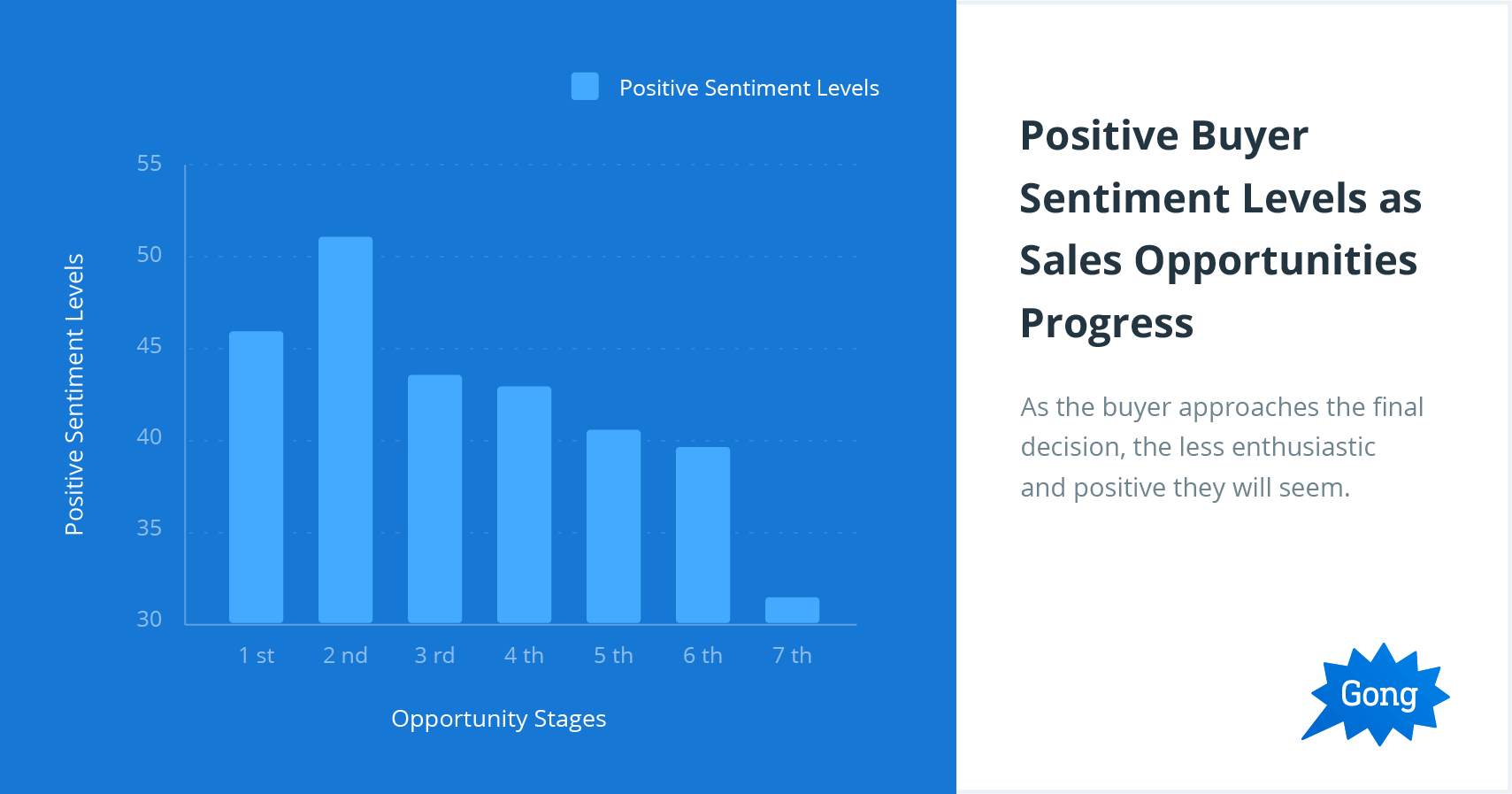
And on the other side, as deals progress toward closure, buyers will more often express negative language and sentiment:
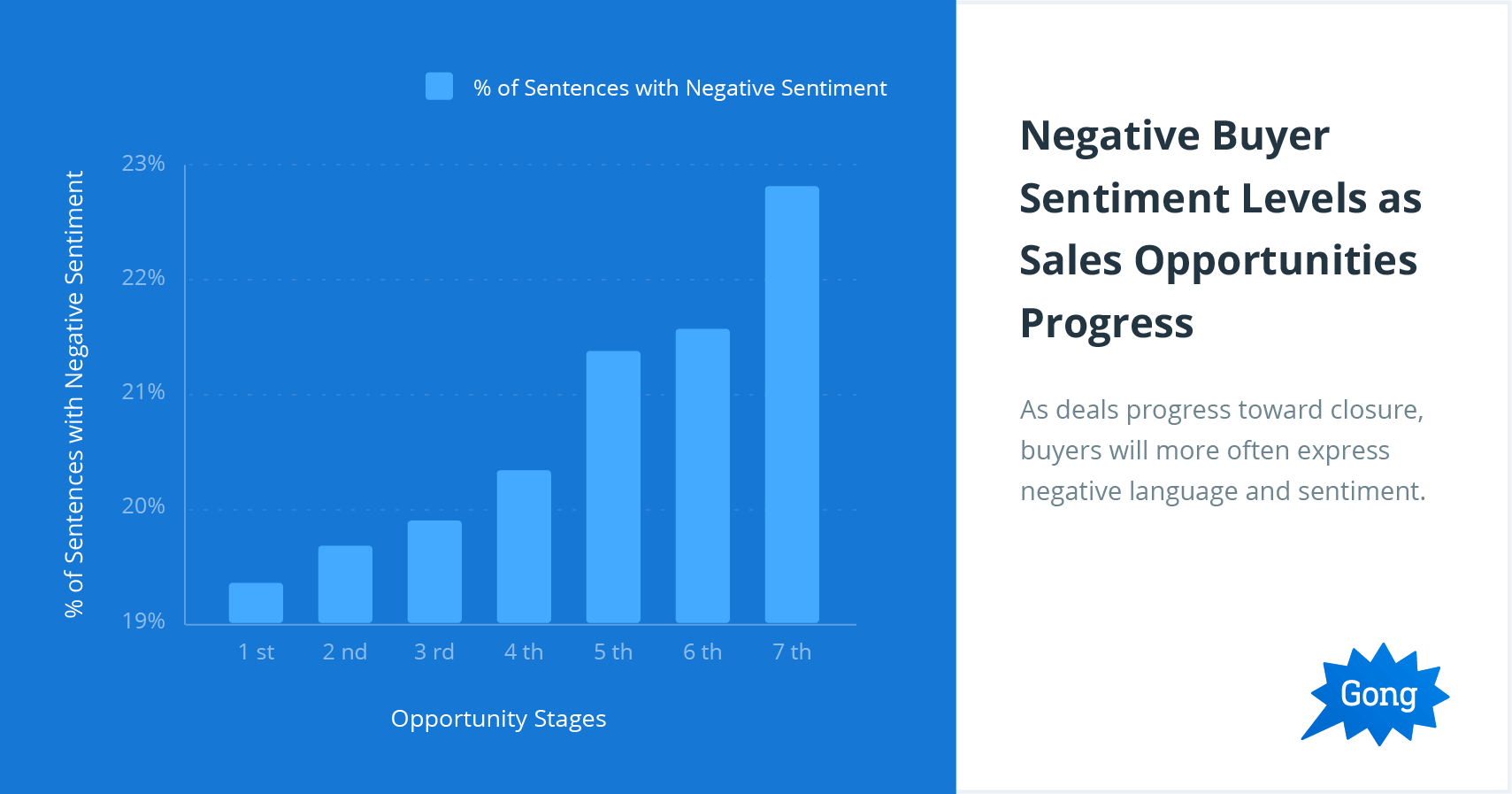
In turn, this is where you step up and lead.
Your job as a sales professional is to help them through those final concerns and emotional hurdles, not back away from them.
And this data should boost your confidence.
Sales Presentation Tip #8: Talk Business, Not Features
As we mentioned earlier, we identified the exact topics that are typically discussed throughout sales presentations, along with the amount of spent on each throughout a conversation.
Superstar reps have business- and value-related discussions far more often than their below-quota peers.
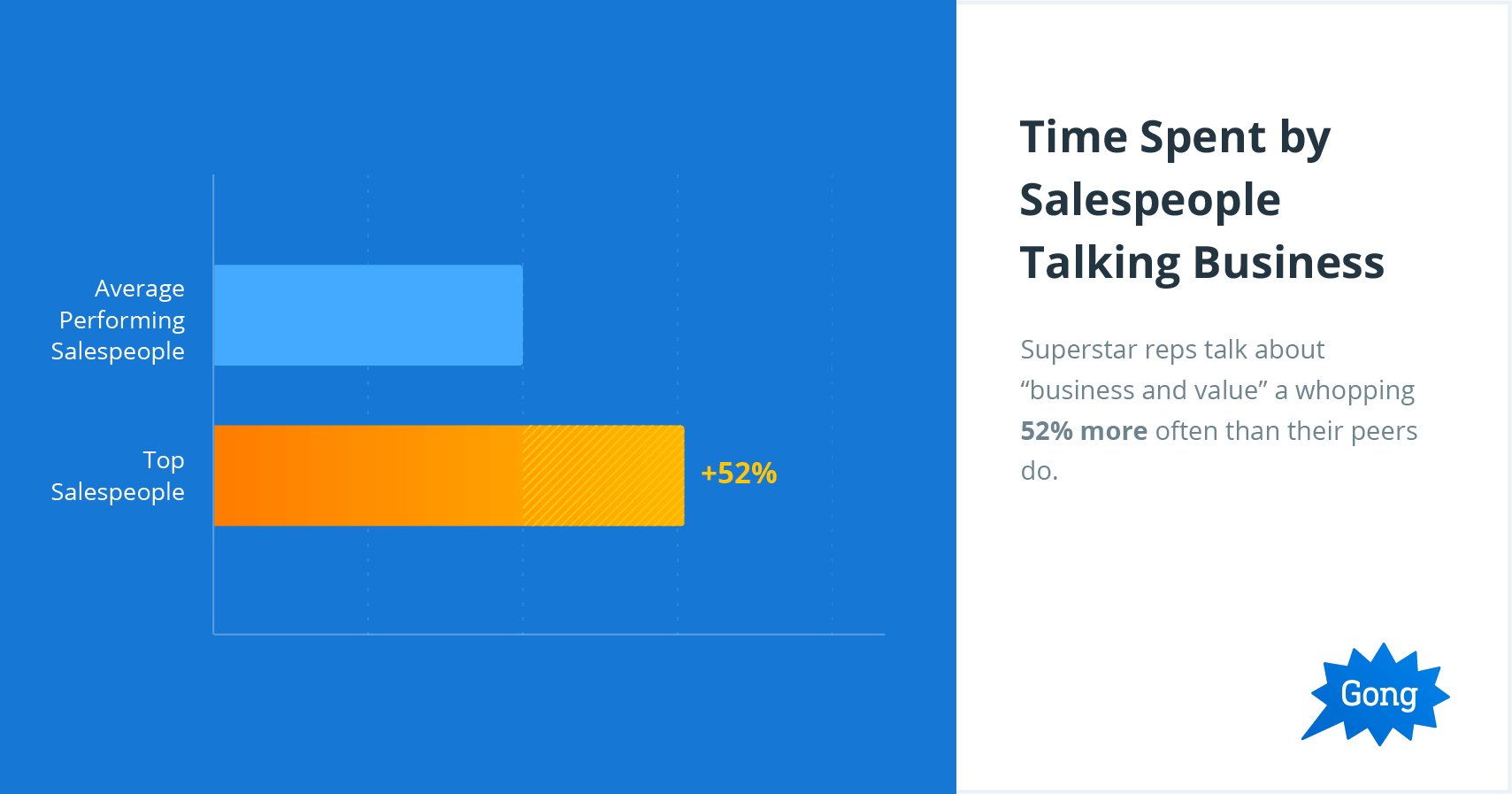
As you can see in the above chart, superstar reps talk about “business and value” a whopping 52 percent more often than their peers do.
For context, here’s an example list of topics that fit into the “business and value” category:
- ROI
- Business challenges
- Business environment
- Decision-making ecosystem
- Ongoing support and project implementation
- Value-related topics
On the other hand, reps that aren’t quite hitting their number are not only addressing business value far less often…
…They’re also feature-heavy rather than business value-heavy:
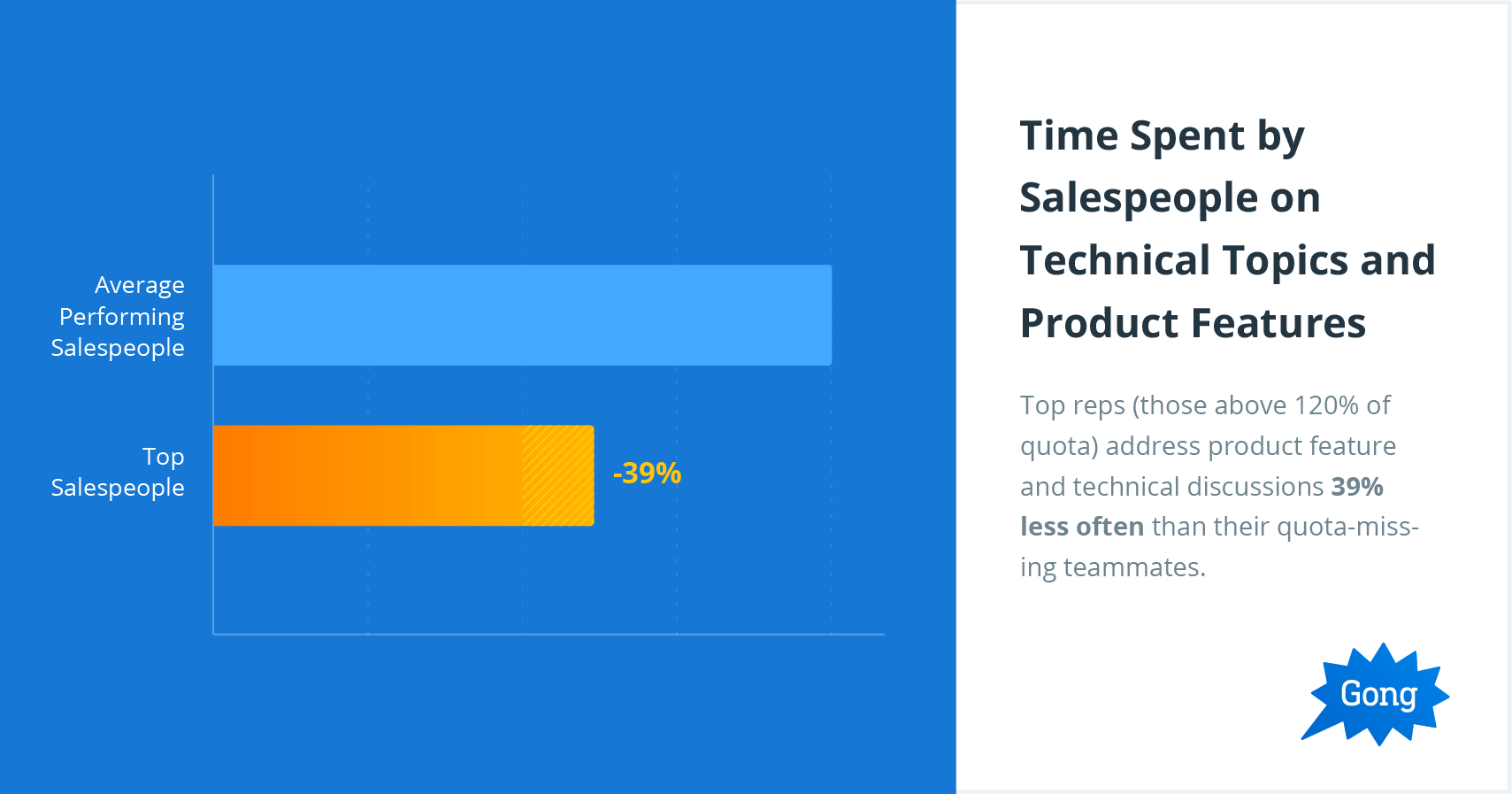
Notice that top reps (those above 120 percent of quota) address product feature and technical discussions 39 percent less often than their quota-missing teammates.
Sales Presentation Tip #9: Don’t Be Too Salesy
People don’t want to be sold to — they want to choose to buy.
For anyone that knows a thing or two about sales, rookie sales tricks are a huge turn-off. And pushing a prospect to close too soon is similarly off-putting.
Focus on helping, not selling.
If your prospect is a good fit, the close will come naturally as you explain how you can get them where they need to go.
If they’re not a good fit, let your prospect go. Suggest alternative solutions to their problems and tell them you’re always here if they need you.
Nothing cements a prospect’s trust in your good intentions than your willingness to walk away from a deal that truly wouldn’t have helped your prospect.
And if one day they do become a good fit, they’ll remember you.
Bonus Tip: Learn From Other Sales Leaders
We recently got in touch with world’s most prominent sales leaders and gurus and asked them about their secrets for what to say in winning sales presentations.
What did we learn?
In the Ultimate Guide to Winning Sales Conversations, they discussed everything from the exact time you should “talk price” to 3 simple questions that move deals forward.
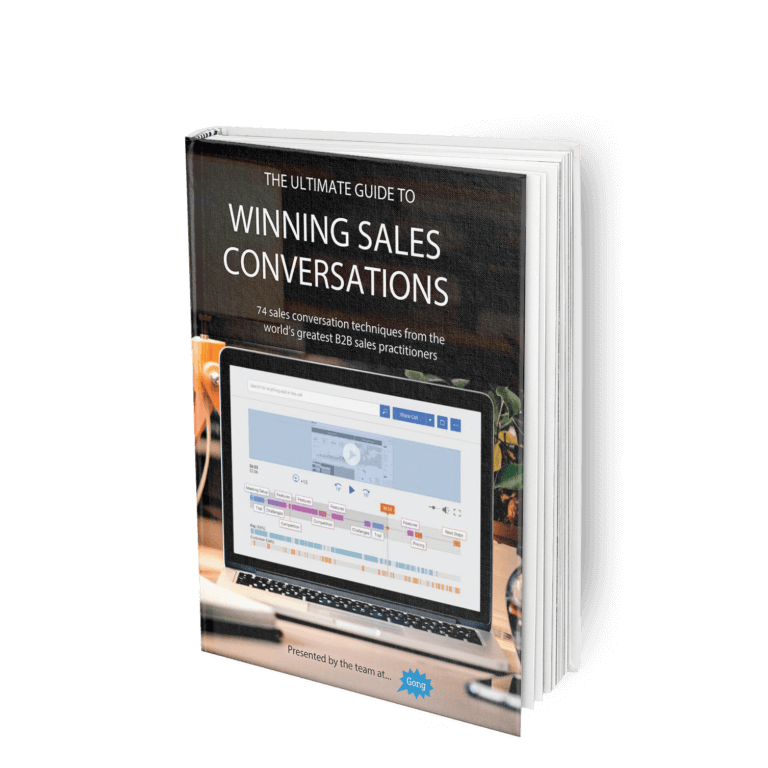
Download your own copy here!
If you liked this article you may also be interested in: